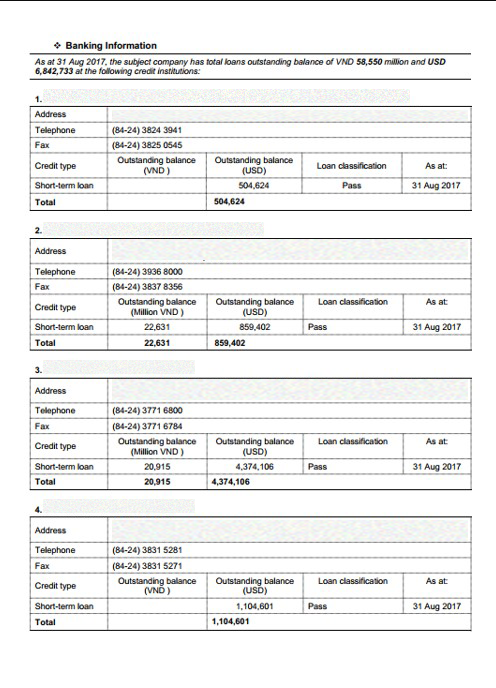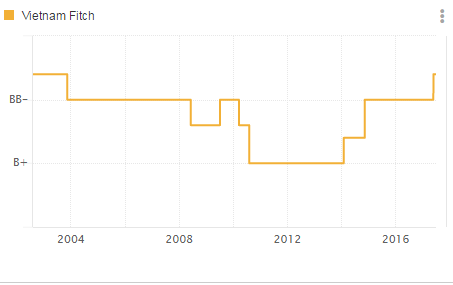There is a fact that everybody makes mistakes. But when it comes to banking information of a company, mistakes can lead to a huge problem. Any action that creates a negative item on the credit report will decrease the credit score of a company
There is a fact that everybody makes mistakes. But when it comes to banking information of a company, mistakes can lead to a huge problem. Any action that creates a negative item on the credit report will decrease the credit score of a company. Too many negative items can lead to high interest rates and rejections on loan applications. Therefore, if a company has these issues, it must know how to negate the impact of negative items in its credit report as quickly as possible.
Being the first credit rating company in Vietnam which was established in 1996, Vietnam Credit has over 22 years of experience in providing reports on the domestic and overseas companies in order to support many organizations and individuals in making their business decisions. To confront the problems mentioned above, Vietnam Credit’s team of expert analysts are willing to give the best pieces of advice.
Legally, they agree that there are four ways to get rid of negative banking information:
Option 1: Banking information repair
This is the most common and usually the best way to get negative banking information removed from the credit report. By law, this type of information can only be included in a credit report if it can be verified by the credit issuer (or collector). If managers believe that an item cannot be verified, they can dispute it with the credit bureau that issued the report. The credit bureau has 30 days to verify the banking information. If it cannot be verified then it must be removed.
This is a process known as banking information repair. It is usually used when a company finds mistakes on the credit report, like a missing payment that it made on time. Since creditors cannot verify erroneous information, this process is the best way to get rid of negative items in the credit report that should not be there.
However, in addition to removing mistakes, it can also be useful to get rid of re-sold collection accounts. Charged-off debts can change hands many times, from one debt buyer to the next. These portfolios of bad debt often include incomplete account information. As a result, the collector cannot verify the original debt. This means with the help of a good banking information checking system, you may be able to tackle this problem wisely.
Option 2: Re-aging
Re-aging refers to the process of bringing account information up-to-date by changing what’s reported to the credit bureaus. There are two types of account re-aging. One of them works in the company's favor to get rid of negative banking information items. The other is bad; it happens when a collector tries to reset the statute of limitations on a collection action.
The good type of re-aging refers to when a creditor updates an account status to bring it current. For example, a company may miss a payment by 30 days. The late payment gets reported to the credit bureaus and appears as a negative item on the credit report. In addition, the account status gets listed as delinquent. Then, the company makes the next monthly payment. The problem is that the company is still behind. That means the account remains delinquent, so the banking information continues to show as behind. Until the company catches up, it is basically stuck getting negative items month after month.
Re-aging means the creditor tells the bureaus the account is current. It is something that the managers can negotiate when they call to set up a repayment plan to catch up. They agree to make payments and work to catch up, they agree to re-age the account so it is current. This is a legal, legitimate way to remove delinquent accounts from the credit report.
Just to clarify, the other type of re-aging involves debt collection accounts. Collectors have seven years from the date an account first becomes delinquent to collect. Some less ethical collectors may attempt to re-age a collection account to change the original delinquency date. This allows them to collect for longer.
Option 3: Pay for delete
This is an option that is similar to re-aging, except it applies to accounts in collections. A collections account gets listed on the company banking information as a public record. So, re-aging will not work because it only updates an active account status. Collections are accounts that already moved to charge-off status. So, the company cannot re-age collections.
What the company can do is to use payment as a bargaining chip to improve the negative information. The company agrees to pay at least a portion of what it owes and they agree to delete the collection entry. The more the company offers to pay, the more likely banks are to agree on a paid negative item removal. This can be a part of the negotiation during debt settlement.
It is worth noting that managers can try to do this retroactively, but it is less likely that the request is a “goodwill deletion” based on the fact that the company paid as requested. However, the results are less assured, because the collector already got what they wanted.
Option 4: Wait it out
This is the easiest option because it does not require any effort except checking the company reports. Basically, the company waits for the clock to run out. Then negative items drop off the banking information naturally. The company simply waits until that happens and then check its reports after the drop off date to make sure the item no longer appears.
The good news is that nothing negative in credit lasts forever. Some bank credit system is pretty forgiving. So, if the company makes a mistake, the impact of the negative banking information item decreases over time. It eventually disappears completely. Most of the credit bureaus remove most negative items after seven years. Some penalties like bankruptcy stick around longer – in that case, ten years.
If the company cannot remove an item through credit repair or negotiating with the creditor to re-age the account, this is really the last legal option that the company has. In this case, it may take steps to build credit. This will allow the company to offset any bad credit effects of a negative item, even before it drops off the report. Since the impact of negative items decreases as time passes, positive actions now can help to recover faster.
























































